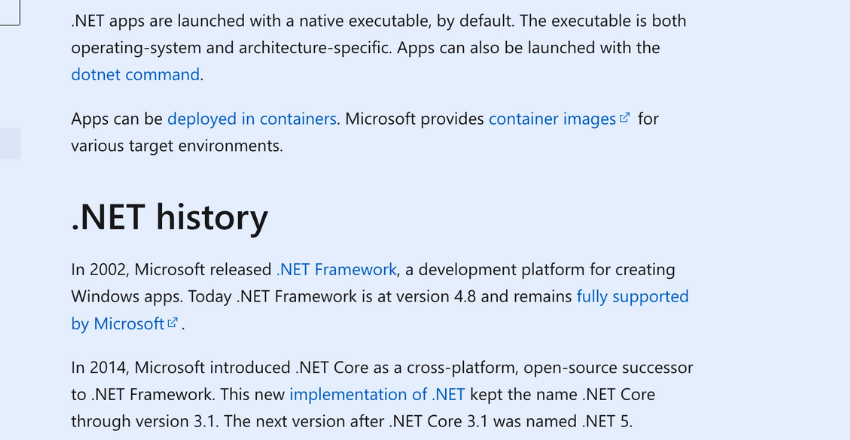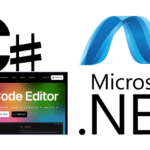
In today’s world of software development, .NET Core has become one of the most popular frameworks for building high-performance applications. But how exactly did .NET Core come to be? In this article, we’ll take a closer look at the history of .NET Core, starting from its early beginnings as the .NET Framework to its present-day status as a key player in the world of programming.
Key Takeaways:
- The history of .NET Core is marked by significant milestones, including the release of version 1.0 in 2016.
- Developed as a successor to the .NET Framework, .NET Core was designed with cross-platform compatibility in mind.
- Since its inception, .NET Core has undergone several major updates and improvements, including the release of version 2.0 in 2017.
Evolution of the .NET Core Framework
The history of .NET Core begins with its predecessor, the .NET Framework. Developed by Microsoft in the early 2000s, the .NET Framework quickly became the go-to framework for Windows-based development. Its popularity stemmed from its ability to provide a consistent and efficient programming model for developers, eliminating the need for manual memory management and supporting multiple languages.
However, with the rise of cloud computing and the increasing importance of cross-platform development, the limitations of the .NET Framework became apparent. Developers required a framework that could run on multiple operating systems and support containerization. In response, Microsoft began development on .NET Core in 2014, with the first release in 2016.
Evolution of the .NET Core Framework
The early releases of .NET Core focused on providing the necessary infrastructure for cross-platform development. As such, the framework was leaner and faster than the .NET Framework, with support for popular operating systems like Linux, macOS, and Windows. However, it lacked some of the features and libraries available in the .NET Framework.
With the release of version 2.0 in 2017, .NET Core bridged this gap, introducing many of the missing features and APIs found in the .NET Framework. This included support for Razor Pages, a popular web development technology, and integration with Visual Studio, Microsoft’s popular development environment. Subsequent releases have focused on improving performance and adding new features, such as support for machine learning and Internet of Things (IoT) scenarios.
Major Milestones in the History of .NET Core
The history of .NET Core is marked by several significant releases and updates. These updates have brought numerous new features and improvements, making .NET Core a powerful and versatile framework for software development. Here are some of the major milestones in the history of .NET Core:
| Version | Date | Features |
|---|---|---|
| .NET Core 1.0 | June 2016 | Initial release, cross-platform support for Windows, macOS, and Linux, lightweight and modular framework |
| .NET Core 1.1 | November 2016 | Improved runtime performance, enhanced networking, support for additional Linux distributions |
| .NET Core 2.0 | August 2017 | Improved performance, compatibility with .NET Framework, improved tooling and development experience |
| .NET Core 2.1 | May 2018 | Improved runtime performance, support for Span, better Docker integration |
| .NET Core 2.2 | December 2018 | Improved HTTP performance, support for ARM32, updated JSON serializer |
| .NET Core 3.0 | September 2019 | Improved performance, support for Windows Desktop applications, updated C# 8.0 language features |
| .NET Core 3.1 | December 2019 | Long-term support release, improved performance, smaller container images |
As you can see, each major release of .NET Core has brought new and important features that help developers build better applications faster. The history of .NET Core is a testament to the power of open-source development and collaboration within the software development community.
Introduction of .NET Core 2.0
One of the most significant milestones in the history of .NET Core was the release of version 2.0 in August 2017. This release marked the first Long-Term Support (LTS) version of .NET Core, which promised to provide stability and support for an extended period.
The .NET Core 2.0 release also introduced a range of new features and improvements, including performance optimizations, better runtime, and improved .NET Standard support.
One of the most notable features of .NET Core 2.0 was its enhanced tooling support, which included new templates, debugging improvements, and performance profiling options. Additionally, the introduction of primitive types such as Span and ValueTuple further improved the performance of the framework.
Another critical update in .NET Core 2.0 was the support for .NET Standard 2.0, which allowed developers to use more APIs than ever before and ensured that libraries written using .NET Framework could be easily ported to .NET Core.
The impact of .NET Core 2.0 was significant, and it solidified the framework’s place as a leading platform for developing modern applications. Its improved performance, enhanced tooling, and better cross-platform support made it an attractive option for developers looking to build scalable, high-performance applications.
.NET Core and Modern Software Development
Since its inception, .NET Core has had a significant impact on the software development industry. It has revolutionized the way developers build and deploy applications by providing a modern, cross-platform framework that can handle complex tasks with ease. In this section, we will explore how .NET Core has influenced modern software development practices.
Impact of .NET Core on Performance: One of the most significant advantages of .NET Core is its performance. The framework is designed to handle high loads and respond quickly to requests, making it an ideal choice for applications that require high performance. Additionally, .NET Core supports just-in-time (JIT) compilation, which allows it to optimize code at runtime and improve performance.
Impact of .NET Core on Cross-Platform Development: Before .NET Core, cross-platform development was a challenge. Developers had to create multiple versions of an application to run on different operating systems. However, with .NET Core, developers can write code once and deploy it on multiple platforms. This feature has significantly reduced development time and costs.
Impact of .NET Core on Containerization: Containerization has become a popular way of deploying applications in recent years. Containers provide a lightweight way to package and deploy applications, making them easy to move between environments. .NET Core fully supports containerization and even includes its own container runtime, making it an excellent choice for containerized applications.
Impact of .NET Core on Open-Source Communities: The .NET Core framework is open source, which means anyone can contribute to its development. This has led to a vibrant community of developers who are constantly improving the framework and creating new tools and libraries. The open-source nature of .NET Core has also made it more accessible to developers, regardless of their budget or resources.
As you can see, .NET Core has had a significant impact on modern software development practices. It has made it easier and more cost-effective for developers to build complex applications, while also providing a framework that can handle high loads and respond quickly to requests. With its cross-platform compatibility, performance improvements, and containerization support, .NET Core is poised to remain a leading framework for years to come.
Notable Features in .NET Core
Since its initial release, .NET Core has gained immense popularity among developers for its advanced features and capabilities. Below are some of the notable features of .NET Core that have had a significant impact on modern software development.
Cross-Platform Compatibility
One of the primary advantages of .NET Core is its cross-platform compatibility, allowing developers to build and deploy applications on multiple platforms, including Windows, macOS, and Linux. This feature has emerged as a game-changer in the software development industry, as it eliminates the need for separate development environments and saves developers time and effort.
Performance Improvements
.NET Core has brought significant performance improvements in terms of speed, memory allocation, and garbage collection. With a faster runtime and efficient memory management, the framework can handle heavy workloads and scale applications to meet changing demands.
Containerization Support
Containerization has emerged as a popular trend in modern software development, and .NET Core fully supports it. With containerization, developers can create lightweight and portable applications, making them easier to deploy and manage. This feature has become a vital aspect of software development, as it allows developers to isolate applications and reduce the chances of conflicts.
Open-Source Framework
.NET Core is an open-source framework that welcomes contributions from developers worldwide. With a vast community of developers and contributors, the framework regularly receives updates and improvements, making it more advanced and robust.
The above features of .NET Core are just a few among many that have made it a popular choice for modern software development. With advancements in technology and the increasing demands of the industry, .NET Core continues to evolve and improve, positioning itself as a critical tool for developers worldwide.
Code Examples in C#
To better understand how .NET Core can be used in real-world scenarios, let’s take a look at some code examples in C#.
Example 1: Console Application
This code example shows a basic console application built using .NET Core:
// Program.cs
using System; namespace ConsoleApp { class Program { static void Main(string[] args) { Console.WriteLine(“Hello World!”); } } }
As you can see, this code is very similar to a console application built using .NET Framework. However, the syntax is a bit cleaner and more modern.
Example 2: ASP.NET Core Web App
This code example shows a basic web application built using ASP.NET Core:
// Startup.cs
using Microsoft.AspNetCore.Builder; using Microsoft.AspNetCore.Hosting; using Microsoft.Extensions.Configuration; using Microsoft.Extensions.DependencyInjection; namespace WebApp { public class Startup { public Startup(IConfiguration configuration) { Configuration = configuration; } public IConfiguration Configuration { get; } public void ConfigureServices(IServiceCollection services) { services.AddControllers(); } public void Configure(IApplicationBuilder app, IWebHostEnvironment env) { if (env.IsDevelopment()) { app.UseDeveloperExceptionPage(); } app.UseRouting(); app.UseEndpoints(endpoints => { endpoints.MapControllers(); }); } } }
This code shows the basic setup for a web application, including middleware configuration and endpoint routing.
These examples showcase just a few of the ways .NET Core can be used in modern software development. Its flexibility and modularity make it a popular choice among developers of all skill levels and project sizes.
Future of .NET Core
The future of .NET Core is bright and promising, as Microsoft continues to invest in the framework and expand its capabilities. The latest version of .NET Core offers improved performance, enhanced security features, and better support for containerization.
Microsoft has also announced plans to release .NET 6, which will merge .NET Core and .NET Framework into a single platform, offering the best of both worlds. .NET 6 promises to bring even more performance improvements and new features, making it an exciting time for .NET developers.
In addition, Microsoft has made a commitment to open-source .NET Core and encourage community involvement in its development. This has resulted in a vibrant ecosystem of contributors and extensions, making .NET Core an even more versatile and powerful tool for modern software development.
Overall, the future of .NET Core looks promising, with Microsoft’s ongoing investment and commitment to open-source development. With its cross-platform compatibility, performance improvements, and other advanced features, .NET Core is poised to continue revolutionizing the world of programming and remain a top choice for developers around the world.
Conclusion
In conclusion, the history and evolution of .NET Core have certainly been impressive. From its beginnings as an open-source, cross-platform framework to its current status as a major player in modern software development, .NET Core has come a long way.
As we have seen throughout this article, the framework has undergone significant updates and improvements, from the introduction of .NET Core 2.0 to its notable features such as cross-platform support and containerization. These advancements have made .NET Core an essential tool for developers and have revolutionized the industry.
Looking forward, the future of .NET Core is bright. Microsoft continues to invest in its development, and upcoming releases are set to bring even more exciting features and capabilities. As the software development industry continues to evolve, it’s clear that .NET Core will remain a critical player.
FAQ
Q: What is .NET Core?
A: .NET Core is an open-source, cross-platform framework for building modern applications. It is a successor to the .NET Framework and provides developers with the flexibility to build applications that can run on different operating systems, including Windows, macOS, and Linux.
Q: How is .NET Core different from the .NET Framework?
A: While the .NET Framework is primarily designed for Windows-based applications, .NET Core offers cross-platform compatibility, allowing developers to build applications that can run on multiple operating systems. Additionally, .NET Core is modular, lightweight, and optimized for performance.
Q: What are the advantages of using .NET Core?
A: Some of the advantages of using .NET Core include its cross-platform support, high performance, improved scalability, and the ability to leverage modern development practices such as microservices and containerization. It also provides access to a wide range of libraries and frameworks that can help accelerate development.
Q: Can I migrate my existing .NET Framework applications to .NET Core?
A: Yes, it is possible to migrate existing .NET Framework applications to .NET Core. However, this process may require some modifications to the codebase and dependencies, as certain APIs and libraries may not be available in .NET Core. Microsoft provides tools and resources to assist with the migration process.
Q: Is .NET Core suitable for both web and desktop application development?
A: Yes, .NET Core can be used for developing both web and desktop applications. It provides support for popular web frameworks like ASP.NET Core and enables the creation of cross-platform desktop applications through frameworks like Electron.NET and Avalonia.
Q: Does .NET Core support containerization?
A: Yes, .NET Core has built-in support for containerization technologies such as Docker. This allows developers to package their applications and their dependencies into lightweight, portable containers, making deployment and scaling more efficient.
Q: What are some notable features of .NET Core?
A: Some notable features of .NET Core include cross-platform compatibility, high-performance runtime, support for modern development practices, modular design, and improved security. It also provides libraries for building cloud-native applications, handling HTTP requests, and working with data.
Q: What is the future of .NET Core?
A: The future of .NET Core looks promising, with ongoing development and updates from Microsoft. The framework is expected to continue evolving to meet the needs of modern software development, with improvements in performance, scalability, and additional features.

Jessica is a highly accomplished technical author specializing in scientific computer science. With an illustrious career as a developer and program manager at Accenture and Boston Consulting Group, she has made significant contributions to the successful execution of complex projects.
Jessica’s academic journey led her to CalTech University, where she pursued a degree in Computer Science. At CalTech, she acquired a solid foundation in computer systems, algorithms, and software engineering principles. This rigorous education has equipped her with the analytical prowess to tackle complex challenges and the creative mindset to drive innovation.
As a technical author, Jessica remains committed to staying at the forefront of technological advancements and contributing to the scientific computer science community. Her expertise in .NET C# development, coupled with her experience as a developer and program manager, positions her as a trusted resource for those seeking guidance and best practices. With each publication, Jessica strives to empower readers, spark innovation, and drive the progress of scientific computer science.






